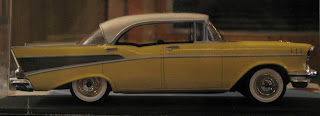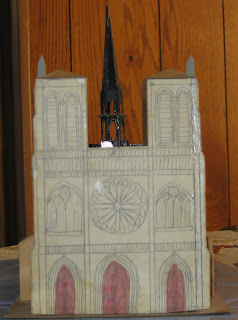
Here is a model of my all time favorite collectible car that I have owned. This is an exact scale model of my first '57 Chevrolet Bel Air 4 door hardtop that I got by trading even up with a buddy I worked with in 1980 for a 1965 Corvair Monza convertible that I was restoring at the time, but I wanted a '57 Chevy more than I wanted a Corvair. When my dad found out that I did this, he was not too happy, and eventually he forced me to sell the car because he said "That big ugly yellow canary will never be worth anything, get rid of it or move out!!" I could not afford to live on my own yet, so I sold the car, after I spent about $700.00 more in 1980 dollars in the start of it's restoration in parts and services. I even got new floor braces, and replacement floor pans for the thing, a rebuilt 1965 Chevelle 283, a rechromed rear bumper assembly, new stock wheels, and hubcaps, and new glass for the driver's side front door. That did not matter, my dad still made me sell it, and I took a beating financially on that car, as I only got $500.00 for the thing, in March of 1983!! Needless to say I was very upset at my dad for forcing me to sell the thing. I still get upset at him for making me do this, as a restored '57 Bel Air 4 door hardtop can now fetch as much as $30,000!! I tried to tell my dad this, but he really does not even want to here it. So be it. When I came home with a 1965 Cadillac Calais coupe later that summer, he liked that car, so everything was at peace on the surface, for the time being.
That is another story for later.
After the '57 was gone, I set out to build a scale model of the thing in around 1984. I used two AMT 1957 Chevy Bel Air 2 door hardtop kits, and one Jo-Han/Ex-el products promotional model re-issue of a 1956 Pontiac Star Chief 4 door hardtop, which uses the exact 4 door HT roof that the 1956, and 1957 Chevys used in the actual cars. So I cut the roof off the Pontiac model. Then After I removed the 2 door HT roof off the Chevy body, I cut the interior hole longer on the cross panel in front of the trunk lid, by making that panel narrower, so it would accomidate the longer modified interior box. I removed the back seat coupe arm rests, and made the rear seat itself, longer, made back door interior panels, and removed the notch that the front seat had, to make a solid front bench seat back, like a fixed sedan front seat would be like. On the body, I shaved off the coupe door handles, filled in the 2 door coupe door lines, and sanded it smooth. Then I scribed the 4 door HT door lines, and sculpted 4 new plastic door handles for the car, and glued them to the doors. After that was done, I glued the Pontiac 4 door roof on, tweaking it quite a bit to get it to fit. Next, I dry fitted the "glass". After that,I dry fitted the new interior box. After I got everything to fit satisfactory, I did all the paint work, and was able to assemble the rest of the model, as per the stock AMT kit's instructions. Oh, yeah, on the front grille, I cut out the grille top bar, and attached it to the hood, like the real car is done.
Even though, I did this model 26 years ago, now, I think it still came out really nice, considering all the work I had to do to the thing to get the results I wanted . And that is a scale model of a 1957 Chevrolet Bel Air "Sports Sedan" 4 door hardtop!
Please check out this new update post I did about this model, as you the viewer have made this my most popular post, so I decided to do new photos of the model, and more info on how and why I built it.
Here is the link.
http://jayveejayaresjunk.blogspot.com/2012/08/1957-chevy-bel-air-4-door-sports-sedan.html
Addendum; February 3, 2013.
To the people of the '55-'56-'57 Classic Chevy Club France, I sincerely thank you for your kind remarks on your forum. I wish I knew French so I could join your forum and talk more about this model, which I built 29 years ago in 1984. I am thinking about building a second 4 door hardtop in India Ivory and Canyon Coral (pink) as I now own a real one in this color scheme. Your remarks, again are much appreciated!--Jim.
Jim.







































